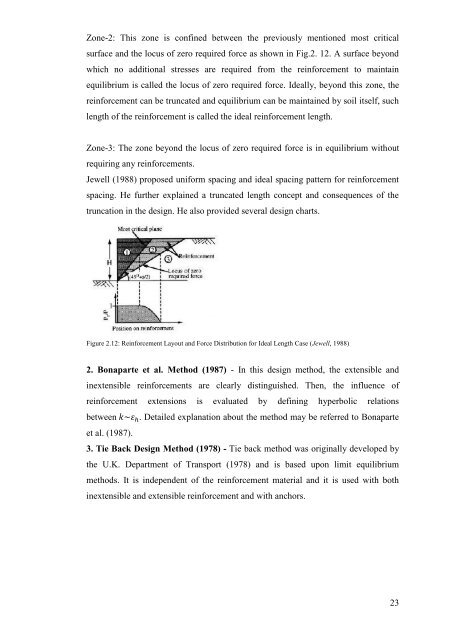Parametric Studies on the Behaviour of Reinforced Soil Retaining
Parametric Studies on the Behaviour of Reinforced Soil Retaining
Parametric Studies on the Behaviour of Reinforced Soil Retaining
You also want an ePaper? Increase the reach of your titles
YUMPU automatically turns print PDFs into web optimized ePapers that Google loves.
Z<strong>on</strong>e-2: This z<strong>on</strong>e is c<strong>on</strong>fined between <strong>the</strong> previously menti<strong>on</strong>ed most critical<br />
surface and <strong>the</strong> locus <strong>of</strong> zero required force as shown in Fig.2. 12. A surface bey<strong>on</strong>d<br />
which no additi<strong>on</strong>al stresses are required from <strong>the</strong> reinforcement to maintain<br />
equilibrium is called <strong>the</strong> locus <strong>of</strong> zero required force. Ideally, bey<strong>on</strong>d this z<strong>on</strong>e, <strong>the</strong><br />
reinforcement can be truncated and equilibrium can be maintained by soil itself, such<br />
length <strong>of</strong> <strong>the</strong> reinforcement is called <strong>the</strong> ideal reinforcement length.<br />
Z<strong>on</strong>e-3: The z<strong>on</strong>e bey<strong>on</strong>d <strong>the</strong> locus <strong>of</strong> zero required force is in equilibrium without<br />
requiring any reinforcements.<br />
Jewell (1988) proposed uniform spacing and ideal spacing pattern for reinforcement<br />
spacing. He fur<strong>the</strong>r explained a truncated length c<strong>on</strong>cept and c<strong>on</strong>sequences <strong>of</strong> <strong>the</strong><br />
truncati<strong>on</strong> in <strong>the</strong> design. He also provided several design charts.<br />
Figure 2.12: Reinforcement Layout and Force Distributi<strong>on</strong> for Ideal Length Case (Jewell, 1988)<br />
2. B<strong>on</strong>aparte et al. Method (1987) - In this design method, <strong>the</strong> extensible and<br />
inextensible reinforcements are clearly distinguished. Then, <strong>the</strong> influence <strong>of</strong><br />
reinforcement extensi<strong>on</strong>s is evaluated by defining hyperbolic relati<strong>on</strong>s<br />
between . Detailed explanati<strong>on</strong> about <strong>the</strong> method may be referred to B<strong>on</strong>aparte<br />
et al. (1987).<br />
3. Tie Back Design Method (1978) - Tie back method was originally developed by<br />
<strong>the</strong> U.K. Department <strong>of</strong> Transport (1978) and is based up<strong>on</strong> limit equilibrium<br />
methods. It is independent <strong>of</strong> <strong>the</strong> reinforcement material and it is used with both<br />
inextensible and extensible reinforcement and with anchors.<br />
23

















